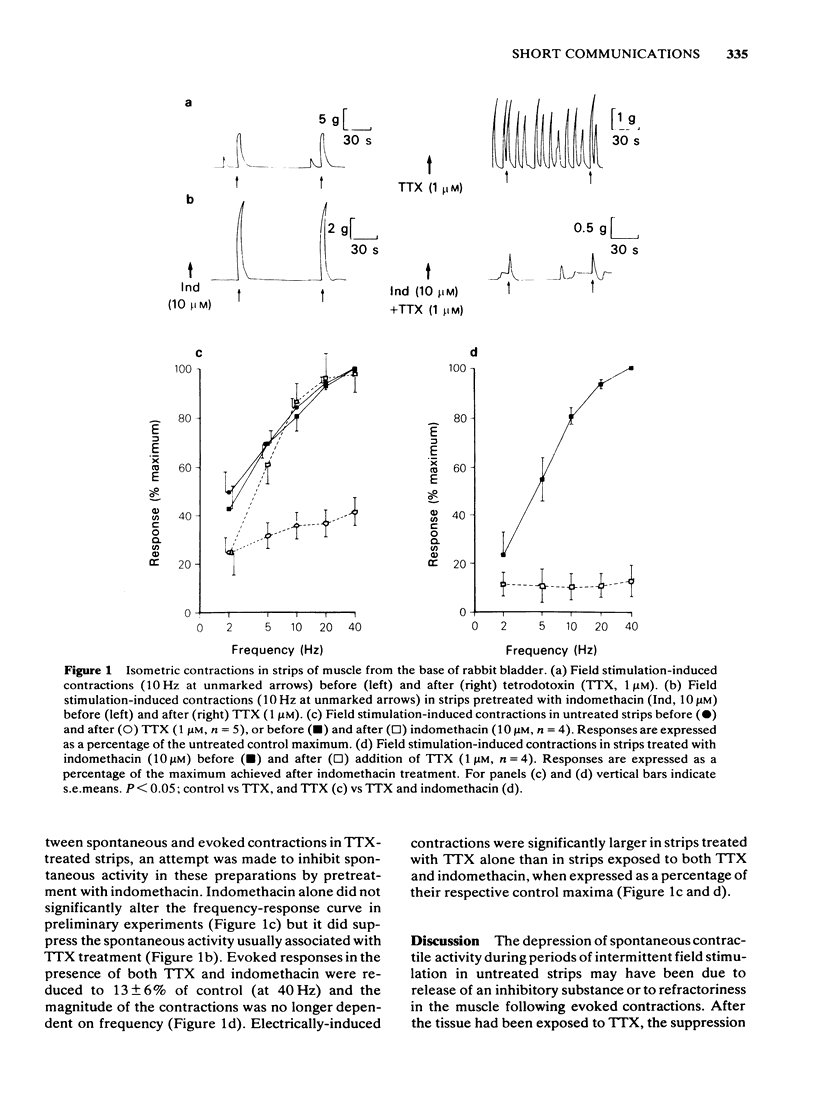Abstract
Tetrodotoxin (TTX) reduced the contractions to field stimulation of strips of rabbit bladder base by 58% of control (at 40 Hz), and increased the spontaneous activity occurring between the evoked responses. The TTX-resistant contractions resembled the spontaneous activity in that they were of comparable size and poorly sustained; in the presence of indomethacin, TTX produced a significantly greater reduction (to 13% of control at 40 Hz), of the evoked contractions. Indomethacin abolished spontaneous activity in the presence and absence of TTX, but did not affect evoked responses in strips that were not exposed to TTX. The results imply that a prostaglandin-like substance may potentiate residual evoked responses in TTX-treated strips, but does not contribute to field stimulation-induced contractions in untreated bladder base smooth muscle.
Full text
PDF


Selected References
These references are in PubMed. This may not be the complete list of references from this article.
- Abrams P. H., Feneley R. C. The actions of prostaglandins on the smooth muscle of the human urinary tract in vitro. Br J Urol. 1975;47(7):909–915. doi: 10.1111/j.1464-410x.1975.tb04075.x. [DOI] [PubMed] [Google Scholar]
- Abrams P. H., Sykes J. A., Rose A. J., Rogers A. F. The synthesis and release of prostaglandins by human urinary bladder muscle in vitro. Invest Urol. 1979 Mar;16(5):346–348. [PubMed] [Google Scholar]
- Daniel E. E., Crankshaw J., Sarna S. Prostaglandins and tetrodotoxin-insensitive relaxation of opossum lower esophageal sphincter. Am J Physiol. 1979 Feb;236(2):E153–E172. doi: 10.1152/ajpendo.1979.236.2.E153. [DOI] [PubMed] [Google Scholar]
- Downie J. W., Dean D. M. The contribution of cholinergic postganglionic neurotransmission to contractions of rabbit detrusor. J Pharmacol Exp Ther. 1977 Nov;203(2):417–425. [PubMed] [Google Scholar]
- Gershon M. D. Effects of tetrodotoxin on innervated smooth muscle preparations. Br J Pharmacol Chemother. 1967 Mar;29(3):259–279. doi: 10.1111/j.1476-5381.1967.tb01958.x. [DOI] [PMC free article] [PubMed] [Google Scholar]
- Johns A., Paton D. M. Evidence for a role of prostaglandins in atropine-resistant transmission in the mammalian urinary bladder. Prostaglandins. 1976 Mar;11(3):595–597. doi: 10.1016/0090-6980(76)90109-x. [DOI] [PubMed] [Google Scholar]
- Krell R. D., Mccoy J. L., Ridley P. T. Pharmacological characterization of the excitatory innervation to the guinea-pig urinary bladder in vitro: evidence for both cholinergic and non-adrenergic-non-cholinergic neurotransmission. Br J Pharmacol. 1981 Sep;74(1):15–22. doi: 10.1111/j.1476-5381.1981.tb09950.x. [DOI] [PMC free article] [PubMed] [Google Scholar]
- Schulz R., Cartwright C. Sensitization of the smooth muscle by prostaglandin E1 contributes to reversal of drug-induced inhibition of the guinea-pig ileum. Naunyn Schmiedebergs Arch Pharmacol. 1976 Sep;294(3):257–260. doi: 10.1007/BF00508393. [DOI] [PubMed] [Google Scholar]
- Slack B. E., Downie J. W., Elbadawi A. Paradoxical resistance to adrenolytic agents of field-stimulated bladder base of rabbit. J Pharmacol Exp Ther. 1982 Jan;220(1):216–222. [PubMed] [Google Scholar]


